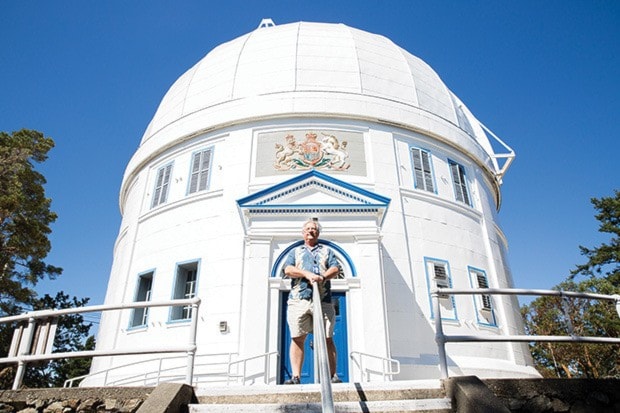For almost a century, the Dominion Astrophysical Observatory has stood as a symbol of greatness in Canadian astronomy.
Since 1918, the domed building has overlooked the rest of Saanich from Observatory Hill while astronomers inside – including Canada’s own John S. Plaskett – made breakthroughs that have shaped our current understanding of outer space.
But why did Plaskett pick Vancouver Island as an appropriate setting for a then state-of-the-art observatory? The answer is two-fold.
“Because it was such a big investment, he convinced people that it should be in the best possible place rather than outside the politicians’ door,” said acting director Dennis Crabtree, noting that a lot of astronomy research at the time was conducted in Ottawa. “Surprisingly for the time, Victoria was the best spot in Canada.
“The glass for the mirror was sensitive to temperature changes. In Victoria, we have more gradual temperature changes, so that’s why it was decided to be the best place to put it.”
Plaskett recognized that in order for Canada to take part in modern astrophysics, they needed a larger telescope and a greater focus on studying stars. He designed the Plaskett telescope, which had a 72-inch aperture, making it the second-largest telescope in the world at the time.
“Its first big project, its reason for being, was to measure the velocities of all the bright stars in the sky,” said Crabtree. “They were able to map out the shape and scale of the Milky Way galaxy for the first time. It was a real major accomplishment at the time.”
Since then, our understanding of the universe has grown exponentially, and scientific advancements have grown beyond the Saanich observatory.
To illustrate the drastic changes in technology, there are two blue circles painted on the observatory parking lot: One 1.83 metres in diameter, representing the Plaskett telescope, and one 30 metres in diameter, representing a telescope being built in Hawaii.
“That’s what 100 years does for technology,” said Crabtree.
While the DAO may not be making scientific breakthroughs like it used to, the National Research Council of Canada, which operates the observatory, is involved in numerous international projects, including studies using the 3.58-metre Canada–France–Hawaii Telescope and the twin 8.1-metre Gemini Observatory telescopes in Hawaii and Chile.
The NRC also develops instruments for telescopes, such as spectrographs and cameras, and houses information for the Canadian Astronomy Data Centre, including data from the Hubble Space Telescope. All that information takes up 1.6 petabytes – equivalent to 1.6 million gigabytes.
While the DAO may not be as scientifically ground-breaking as it used to be, the observatory is a testament to how far astronomy has progressed in 100 years – and how much further it can go.
“My first trip over here was when I was an undergrad at UBC in 1974. Even since then, it’s unbelievable,” said Crabtree of how our knowledge of the universe has changed.
“I’ve been involved in this a long time and I still think it’s cool stuff.”
